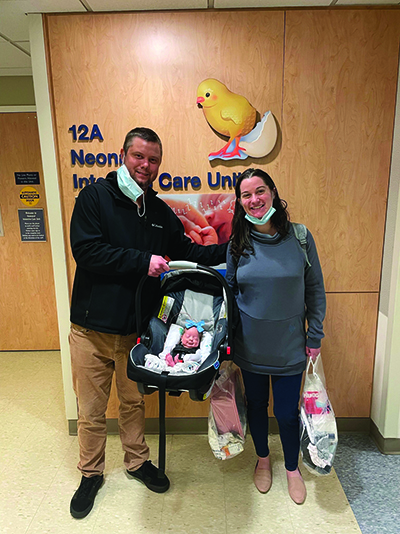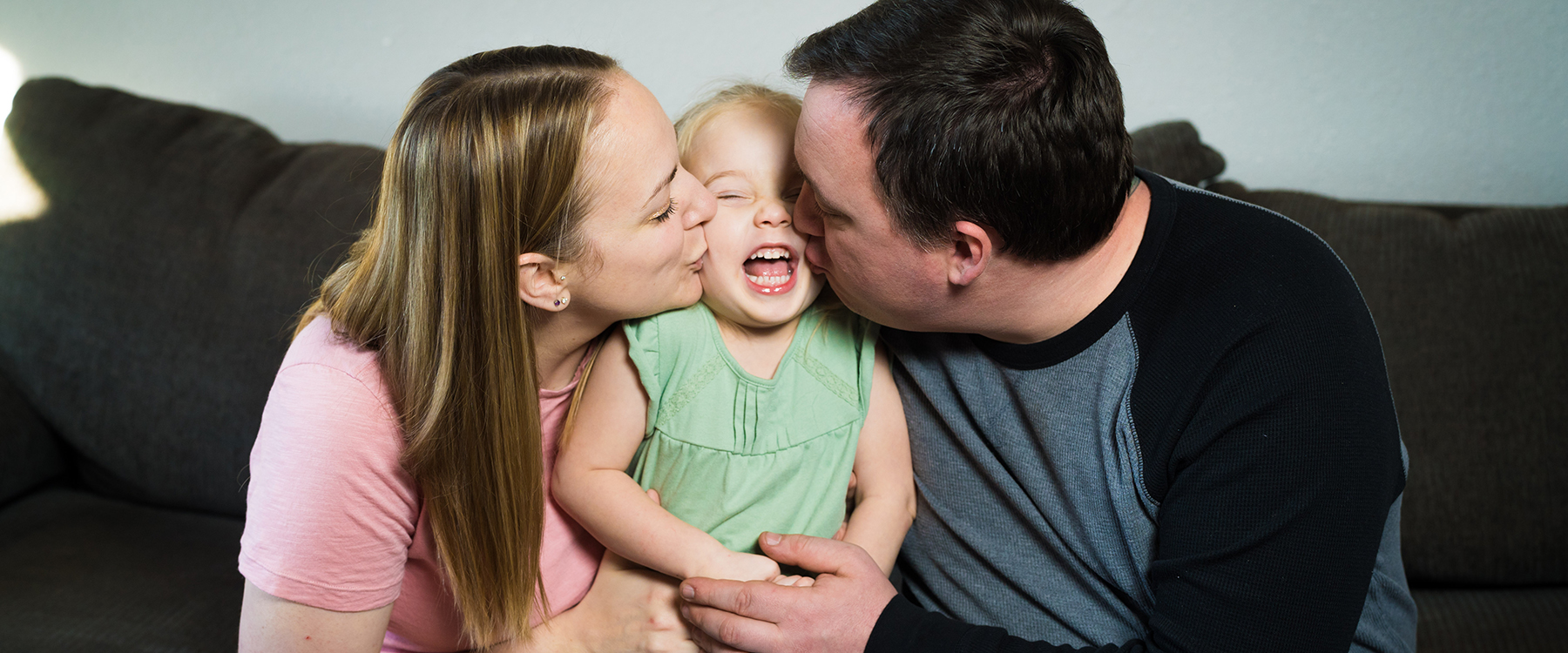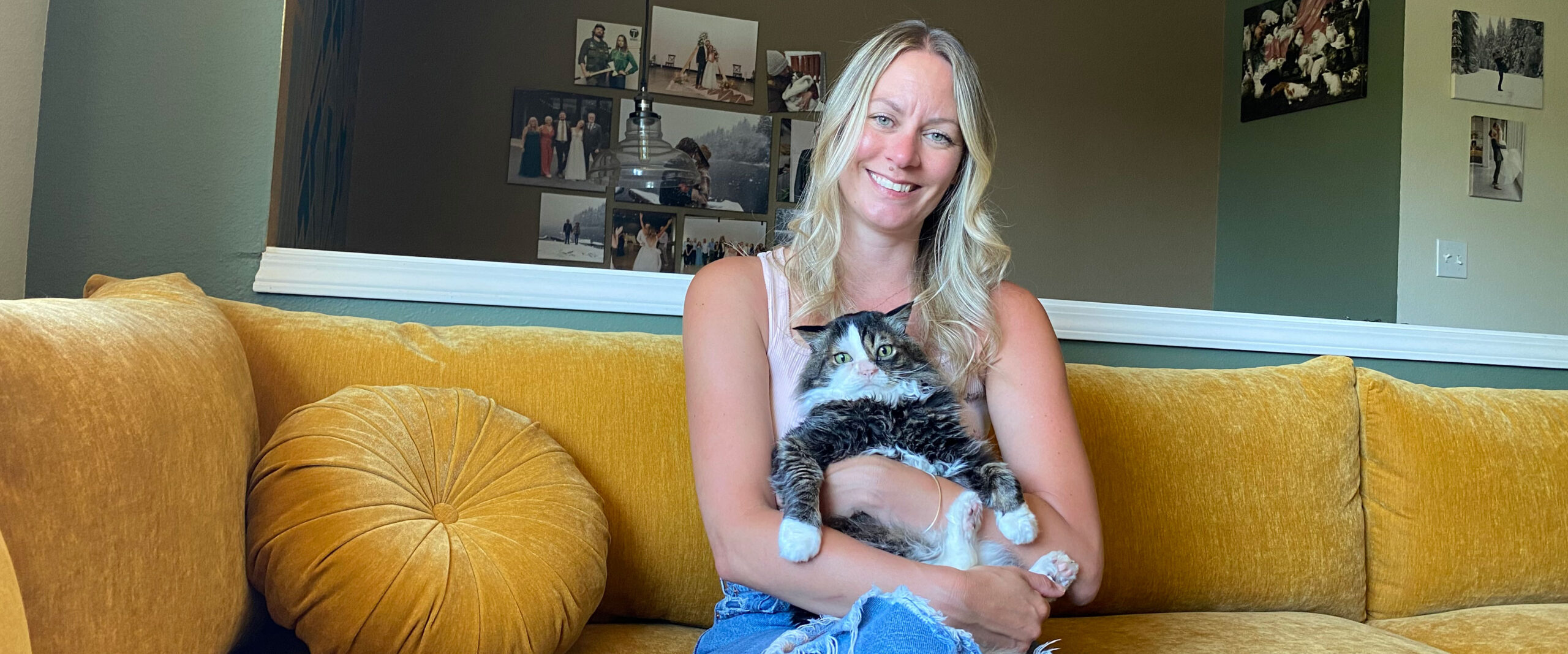By Willow Bacon
For Ignite Magazine
For parents with an infant in the neonatal intensive care unit (NICU), only one thing matters: bringing their baby home.
No one knows this better than Brittney and Austen Goss, whose daughter Harley was born at 32 weeks after an anguishing loss.
“I was originally pregnant with twins, but we lost Baby B at 31 weeks,” Brittney said. “I remember it was on a Friday, and by Monday it became clear that Harley was in jeopardy, too. She was delivered by C-section on February 12, 2020.”
Although Harley was relatively healthy, she was too small to be fed via breast or bottle and required the support of extra oxygen. So rather than taking their tiny daughter back to their home near Salem, Oregon, Brittney and Austen settled in for a long vigil in the NICU at OHSU Doernbecher Children’s Hospital.
“The doctors and nurses did an exceptional job, but it was hard for us to be away from our home, our extended family, even our dogs for such a long period of time,” Brittney said. “It was an odd mix of feeling disconnected from everything, yet hyperfocused on Harley and what she needed.”
Four weeks later, Harley was growing stronger, but still needed to be on a feeding tube to help her gain weight. The Gosses had resigned themselves to continuing their hospital stay — then they learned that their daughter was eligible for a new, at-home monitoring program that would allow her to go home in a matter of days rather than months.
Updating the discharge process
Before a baby can be discharged from the NICU, they need to be able to breathe on their own, maintain a stable body temperature without the use of an external heater and eat everything needed for growth by mouth. Newborns often achieve stable breathing and body temperature before learning how to fully feed orally, which can extend a hospital stay significantly. Though a baby might be almost fully healthy, staff still need to feed them, record how much they ate and weigh them at regular intervals.
Support the Growing@Home program
Realizing that parents could easily perform many of these tasks on their own and seeing the success of the Doernbecher pediatric cardiology Interstage Remote Monitoring program, providers in the Doernbecher NICU discovered a way to use similar technology to manage babies who required neonatal intensive care. In 2019, generous pilot funding from Mark and Debra Madden made the creation of the NICU remote monitoring program a reality.
“Research has proven that infants develop better in their home environment, so that’s where we want them to be.”
Jamie Warren, M.D., M.P.H.
Called Growing @ Home, it uses an innovative digital platform to help parents do the feeding and monitoring at home that would typically be done at the hospital.
“It’s truly groundbreaking,” said Jamie Warren, M.D., M.P.H., head of the Growing @ Home program and associate professor of pediatrics (neonatology) at the OHSU School of Medicine. “Because the program offers access to the same tracking capabilities available here at Doernbecher, it’s allowing parents to go home and bond with their baby in a more comfortable, private setting. Research has proven that infants develop better in their home environment, so that’s where we want them to be.”
With Growing @ Home, parents can easily log their child’s vitals into a specialized medical app, which links seamlessly to the hospital and is reviewed daily by their infant’s medical provider. They can even upload photos and videos of potential health concerns. Should a complication arise, the app provides red-flag warnings to parents and directs them on which steps to take next.
“We wanted to feel like we had a safety net.”

When an infant meets the criteria for early discharge through Growing @ Home, the NICU medical team approaches the parents and asks if they’d be interested in participating. Some prefer to keep their child under the watchful eye of the NICU — others, like Amanda and Daniel Clark, are eager to transition to home monitoring.
When the Clarks’ daughter Clementine was born prematurely, she weighed in at just 2 pounds and 15 ounces. To complicate matters further, COVID restrictions meant that only one of them could be in the NICU with her at a time.
“Not being able to be together with Clementine was really hard,” said Amanda. “All we could do was take turns holding her, encourage her to eat, just do anything we could think of.”
Once Clementine had stabilized, the focus turned to making the transition from hospital to home. Daniel admits that the prospect felt a little daunting.
“You get used to all these doctors and nurses helping you, and we were worried about losing that built-in support network,” he said. “We wanted to feel like we would have a safety net in place.”
According to Warren, those feelings of trepidation are both normal and understandable.
“It can be hard to get comfortable with the fact that suddenly you won’t be surrounded by medical staff at all times,” she said. “That’s why a lot of the program is centered around helping parents feel confident before they go home.”
To ease their anxieties, parents are thoroughly trained on everything from how to insert and manage a feeding tube to obtaining weights and entering data.
“The feeding tube took a bit of getting used to,” said Amanda. “Clementine was barely the size of our hand — I thought there was no way we could put a tube down her nose. But once they showed us how, I was amazed at how easy it was.”
“They really prepared us so that when we brought Clementine home, we didn’t feel like ‘Oh my god, we’re on our own,’” added Daniel.
Days' worth of NICU beds that are saved for patients with the greatest need
1,500
Median number of days that eligible NICU patients can be discharged sooner
7
Average cost savings per family, per week when participating in the Growing @ Home program
$7,000-$10,000
Babies and families supported by the program to date
150+
Babies who were able to go home earlier than anticipated in 2022
49
Bringing baby home
When parents leave the hospital, they’re armed with feeding equipment, a scale and the Growing @ Home app. They also remain in constant contact with Warren and her team, who check in daily to answer questions and offer reassurance over matters both large and small.
“I could call up to the NICU day or night and ask them anything,” Brittney said. “I remember once feeling concerned because the color of Harley’s poop had changed. I was able to literally take a picture of her poop and send it to Dr. Warren so she could tell me if it was normal or not.”
The Clark family was also grateful for the ongoing support. “We spoke with Dr. Warren literally every day, asking about everything from feeding to safe sleep,” Amanda said. “She talked to us not only as a doctor, but also as parents.”
Nearly one year later, their daughter Clementine is a thriving little girl who loves to help out in the kitchen.
“She’s my little chef,” smiled Amanda. “I remember on my first Mother’s Day I got to have breakfast in bed with her. Without the Growing @ Home program, we wouldn’t have had that time together.”
And as for Harley? She’s a sassy, adventurous toddler who enjoys playing outside, cuddling the family dogs and making up fantastic stories starring her favorite toys.
The benefits go beyond early discharge
Although Warren and her team started Growing @ Home as a way to help babies go home sooner, they quickly realized that the program had another benefit: significant cost savings for both the hospital and families. The math breaks down like this: A day in Doernbecher’s NICU costs a minimum of $1,000, and the program allows babies to go home an average of seven days sooner.
That’s between $7,000 to $10,000 saved per patient every week in hospital costs that aren’t being billed to insurance, Medicare or families.
The savings manifest in other ways, too. Many families live more than an hour from Portland and have jobs that they need to maintain, which would require hours of extra driving each week. There’s the cost of gas, meals away from home and childcare for other kids in the family. Being able to take their baby home helps ease many of those financial burdens.
More beds for the babies who need it most
Doernbecher’s NICU offers the most advanced neonatal care in Oregon, but only has the capacity to treat up to 50 infants at a time. When that capacity is exceeded, it sometimes becomes necessary to send families to a different NICU in the area.
“It doesn’t happen frequently, but being able to discharge just one or two babies a week through the Growing @ Home program opens up a bit of extra breathing room so that when a critically ill baby comes in, we have a bed ready for them,” said Warren.
Since the program began, over 150 babies have been able to go home earlier. That translates to nearly 1,000 days’ worth of beds in the NICU.
Born out of philanthropy
Perhaps the most remarkable aspect of the Growing @ Home program is that every aspect of it is still funded though the generosity of donors.
“We simply wouldn’t be here without philanthropy,” said Warren. “From the initial concept to the design of the app to ongoing operations, it’s all made possible through donor funding — and will continue to be for the foreseeable future.”
That’s something that fills the families impacted by Growing @ Home with profound gratitude.
“It’s a debt you can’t repay,” said Austen. “I think it’s amazing that there are people out there who are willing to stand up and say, ‘Hey, we’ve got an abundance of babies here at the hospital. What can we do to help get them home sooner?’ I’d shake their hands if I could, because they changed our lives forever.”




